From the June 2016 issue of GCM magazine:
In the clear
Hosting another U.S. Open, famed Oakmont Country Club has become a model for tree removal as it looks to the future with an eye on its past.

Photos by Fred Vuich
Howard Richman
Read this story in GCM's digital edition »
John Zimmers Jr. points to an elm tree that stands near the third tee. No need to ask him which one. By design, it is a loner.
“That’s one nervous tree,” Zimmers says.
The solitary elm at Oakmont Country Club, along the Allegheny River in western Pennsylvania, symbolizes the past, present and future of this bucket-list destination. Not all that long ago, this particular elm tree, which is the only one that remains on the golf course’s interior, was among a sea of its kind, along with blue spruce, pine and other varieties.
Many others.
According to Zimmers, who is in his 17th season as the GCSAA Class A superintendent at Oakmont, approximately 14,500 to 15,000 trees have been removed in about a 25-year span. About 7,000 of them were eliminated leading up to the 2007 U.S. Open there. Since then, about 7,500 more trees have been purged, most prominently along the par-5 12th. Otherwise, only a handful of trees remain near the clubhouse.

The 18th hole at Oakmont CC is a picturesque par-4 closing hole. In the 1927 U.S. Open, Tommy Armour birdied this hole to force a playoff, in which he prevailed over Harry Cooper.
Tree ya later? Exactly.
“The views you get now are just astonishing. It reveals this beautiful piece of land, and really shows off the architecture. Now, you can see everything. This is visionary,” says Zimmers, 45, a 23-year member of GCSAA.
All of this tree removal was anything but a snap decision — some people threatened lawsuits to save the trees, while others even prayed for their preservation. All of it, though, was for a reason. In essence, it honors a man who has been dead for 81 years: H.C. Fownes, whose only golf course architecture design is arguably one of a kind. Ranked No. 6 by Golf Digest in its “America’s 100 Greatest Golf Courses,” Oakmont will distance itself even further from the rest come June 16 through 19, when it hosts the 116th U.S. Open for a record ninth time.
Oakmont’s present-day appearance is an ode to Fownes, who founded the club in 1903. Back then, it was a wide-open links-style layout, peppered with shallow, penal bunkers and void of tree mass — a transformed piece of farmland split by the Pennsylvania Railroad.
One hundred years ago, Oakmont first surfaced on the marquee by hosting the 1916 Intercollegiate Golf Association of America Championship. In time, an array of notable events would follow. In the 1962 U.S. Open, Jack Nicklaus recorded his first major championship there. In 1973, Johnny Miller posted a final-round 63 to capture the U.S. Open. At the time, it was the lowest round ever recorded in a major championship, and it remains one of only four 63s at a men’s U.S. Open.
“If you’re a member of Oakmont Country Club, you have got championships in your DNA, says Mike Davis, executive director and CEO of the USGA. “I’ve certainly not seen a golf course around this country that is more focused on championships than Oakmont Country Club.”

|
 |
|
Extensive tree removal at Oakmont CC is showcased
in this before-and-after overview.
|
Charlie Howe, USGA championship manager, says, “History seems to happen here. It seems the best golfers for generations are identified here.”
Speaking of identity, Oakmont has its back. The place must closely resemble what Fownes viewed the last time he laid eyes on it. From the back porch of the clubhouse, you can now almost see the entire course, save for the 16th green, which rests below the line of sight.
Although it has taken a page from its past, Oakmont has had an eye toward the future for a while. In between major tree removals, Oakmont installed a new irrigation system, ditches that can come into play were restored, and the club has reduced its overall water use by 45 percent. No wonder, then, that golf course designer and restorer Ron Prichard considers what Oakmont has done to be revolutionary.
“It was reassuring that someone had that kind of courage. They had more courage than I would have had,” says Prichard, whose work includes TPC Southwind in Memphis, Tenn. “They carried it (tree removal) to the limit. It was brave. Oakmont’s always been a little bit ahead of the curve in some respects. They give the golf course a lot of thought.”
Actually, Prichard says he wishes that Fownes had done more courses. After all, Oakmont is registered as a National Historic Landmark. “That was his one passion, that one course, and he was satisfied by it,” Prichard says. “In some respects, though, it is good that it is the one course he did. It’s kind a masterpiece, isn’t it?”
Copy if you please
Regardless of whether it was intentional, Oakmont’s tree removal plan is an industry benchmark. “Somebody has to be the explorer so the rest of us can follow,” says Matt Shaffer, director of golf course management at historic Merion (Pa.) Golf Club, and a 35-year GCSAA member. “For the rest of us, it’s been easier to utilize Oakmont as the example of what can be done.”
Chris Tritabaugh, the GCSAA Class A superintendent at Hazeltine National Golf Club in Chaska, Minn., says that Oakmont’s monumental tree removal has created a buzz. “I can say an industry-wide observation is that they can be credited for getting a lot of the industry on board,” says Tritabaugh, a 16-year member of GCSAA who is prepping for the Ryder Cup in September. “I think it’s obvious to anyone looking at their course what an improvement it was. It was dramatic.”
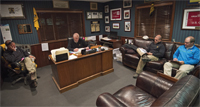 |
|
Golf course superintendent John Zimmers Jr., seated behind his desk, discusses daily duties with his staff.
|
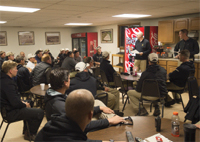
|
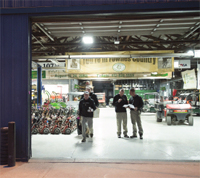 |
|
Zimmers and staff
in preparation mode.
|
For John Clark, it is an inspiration. At Rochester (N.H.) Country Club, where Clark is the GCSAA Class A superintendent, he has used Oakmont as a model to pursue his own goal of tree removal. “I saw pictures of Oakmont. I remember seeing it and thinking that I’m moving in the right direction. If a well-established club like Oakmont was doing this, I thought that I may have success doing it as well,” the 21-year GCSAA member says.
Not all tree removal plans earn approval, however. In April 2015, San Benito County officials supported a ban that made it illegal to remove trees at Ridgemark Golf & Country Club in Hollister, Calif. Many in the industry, though, are convinced tree removal is beneficial for numerous reasons. It creates more sunlight, improves airflow, upgrades turf quality.
Golf course architect Bobby Weed, a former certified superintendent whose design Old Farm Golf Club in Bristol, Va., was voted Golf Digest’s best new private course in 2000, understands just what Oakmont has accomplished. “Personally, the wider the corridor, the more options and interest you have,” Weed says. “I learned a long time ago from Pete Dye, don’t build a golf hole around a tree because there’s a good chance that the tree is not going to stand up over the long term.”
Oakmont started planting trees in earnest in the 1960s as part of a beautification program. Shaded, heavily tree-lined fairways became the norm. Later, a movement by some at the club to restore Oakmont to its original appearance was met with resistance and, yes, people who prayed for the trees. “I heard those stories about the prayers. That’s a true story. It didn’t work,” says Oakmont member Banks Smith, a former club president and grounds chairman who helped authorize the tree removal.
Actually, tree removal at Oakmont began on superintendent Larry Napora’s watch. It was right about 1990, Napora recalls, when approximately 100 trees were eliminated. Members didn’t notice, he says, because the trees that vanished were inside dense clusters. “They were growing into each other,” says Napora, currently director of golf course operations at Firestone Country Club in Akron, Ohio. “I went back in 2007. I was in awe. I never thought they’d go that far.”
It was an only-scratching-the-surface moment in Napora’s day. The club took it up a notch under Mark Kuhns, CGCS, who remembers an occasion when he was standing on the back of Oakmont’s 16th green and a pine tree limb was hanging so low that it brushed against the back of his head. Kuhns ultimately supervised a series of overnight tree operations that he and his staff undertook in order to be discreet. They would pull up their vehicles with beaming headlights to target trees, cut them down, remove any remnants, and have things ready for play the next day.
“He (Banks Smith) would just point to a tree. He didn’t have to say anything,” says Kuhns, a 35-year member of GCSAA who is now director of grounds at Baltusrol Golf Club in Springfield, N.J., site of next month’s PGA Championship. “People began to notice. It got interesting.”
Mickey Pohl, general chairman for the 2007 U.S. Open, says shot-making vastly improved after the tree removal process became public. In time, many members agreed.

Oakmont CC’s clubhouse opened in 1904. The cost to build it: $38,000. Photo courtesy of the USGA
“It wasn’t really fair to good players (with the trees). If you got a big tree between you and the green, you could hit the best shot in the world and it still could be doubly punitive,” Pohl says.
Smith seems vindicated. “The concern was they’d shoot lights out on this golf course. Well, they didn’t. It hasn’t gotten any easier. We still have 210 bunkers (including those famous Church Pew bunkers). I don’t think anybody in the Pittsburgh area is saying it’s a piece of cake,” Smith says.
If there were ever a sign that peace has come for those who opposed tree removal at Oakmont, look no further than Kuhns, who departed in 1999 and was replaced by Zimmers. “I still get Christmas cards from about 25 members,” Kuhns says.
For Zimmers, Oakmont is a more excellent agronomic adventure nowadays with the trees out of his way. “Frost burns off faster. If it rains, it dries faster. We need less water, less fertilizers,” he says. “If there’s anything that’s a little negative, it’s winter. The snow can blow around out here, so some of the ground becomes bare. This year, we went with a very aggressive approach. We covered all the greens and put up a wind protection fence on all 18 greens. Overall, though, no question it’s better for everybody — for golfers, for superintendents.”
When one door closes ...
Baseball’s loss was the superintendent profession’s gain.
 |
|
Zimmers (left) and David Delsandro, director of U.S. Open operations and projects, check out the course.
|
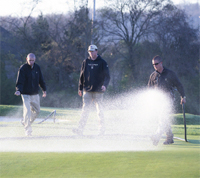
|
|
Zimmers, Matt Vos (center) and Mike McCormick on one of Oakmont’s greens, which are expected to be fast and firm for the U.S. Open.
|
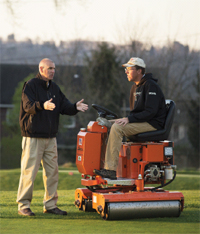 |
|
Zimmers and Vos go over their game plan at Oakmont CC, which hosts its ninth U.S. Open this month.
|
“Pitching was my dream,” says Zimmers, who in his youth played against Stan Belinda, who would end up pitching in relief for the Pittsburgh Pirates in the 1992 National League Championship Series. For Zimmers, the dream was derailed. While on the mound throwing a pitch, he heard a pop in his arm. Zimmers suffered a broken elbow.
“I had pretty good stuff,” he says. “It just wasn’t meant to be.” Instead, he forged a work ethic he had learned from his grandfather, also named John Zimmers. The elder Zimmers had worked in a paper mill for 43 years. “Besides learning about hard work, I learned honesty. Just be honest,” Zimmers says.
Zimmers took a job as a teenager at Wertz Landscape, which served as the introduction to his career path. He was perusing the classified ads in the Altoona Mirror when he saw that Wilmington (Del.) Country Club needed a grounds employee. Zimmers interviewed with legendary superintendent Paul R. Latshaw. “I got the job, but I had no idea at age 19 I was working for probably the best superintendent at the time,” Zimmers says of Latshaw, whose stellar résumé includes Oakmont, Congressional Country Club and Augusta National Golf Club.
“He (Zimmers) worked very hard to get where he is. He is a perfectionist,” says Latshaw, who was in charge at Oakmont for the 1978 PGA Championship and 1983 U.S. Open. “He’ll never accept ‘no’ as an answer.”
When Latshaw left to take the job at Congressional, he brought Zimmers with him — for a while, at least. He told Zimmers it was time to leave when an opportunity opened up in Ohio. Zimmers listened, taking the position as grow-in superintendent at Sand Ridge Golf Club. “It was one of the best grow-ins I’ve ever seen,” says Dick Bator, another industry legend who served as superintendent at both Oak Hill Country Club in Rochester, N.Y., and Merion. “It was a tough piece of property. Soil was bad, potential washouts, sloped, heavily treed. John made it consistently even. I could tell when I first met him he had superstar qualities. His dedication set him apart.”
Zimmers, who obviously had his own mentors, is now the mentor. “Without John, I wouldn’t be anywhere,” says David Delsandro, director of U.S. Open operations and projects at Oakmont. “He believed in me more than I did. He has foresight, vision. We’ve created a culture, and that’s what it’s all about. After a time, that culture maintains.”
Oakmont assistant superintendent Mike McCormick says, “At the end of the day, the reason I came to work here was for John. He has such a passion for what we do and for
our industry.”
Shaffer, who had Zimmers as his wingman for the 2013 U.S. Open at Merion, will be returning the favor this month. “He’s really fussy, fastidious, detail-oriented. And he’s really, really exceptional,” Shaffer says of Zimmers.
Latshaw also plans on making an appearance. In fact, Latshaw came to see Zimmers during that 2007 U.S. Open. Their conversation as they stood on the fourth tee before play began is a keepsake for Zimmers. “He said, ‘Mr. Zimmers, I think you have beaten me on this one.’ It wasn’t about beating him,” Zimmers says. “It was about making him proud.”
(U.S.) Open for business — again
Lee Trevino once said that you could step onto Oakmont at a moment’s notice and hold a U.S. Open. On March 17, Darin Bevard sure gave it a thumbs-up.
Bevard, director of championship agronomy for the USGA, had stopped by Oakmont that day to see how things were progressing. “It was great. With no winterkill, I was like, ‘All right, this is going to be fun.’ With John’s skills and with no significant turf problems, you know you’re going to have great conditions for a U.S. Open. It’s not going to be an agronomic issue. If anything, it’d be a Mother Nature issue,” Bevard says. “It’s great how it’s changed with the tree work. Architecturally, it’s really cool.”
As always, the greens are fast. Members request it. Come fall, some of the best players at the club will gather for an event in which Zimmers says the Stimpmeter easily reaches 15.

Massive tree removal at Oakmont CC includes more than 7,000 of them that have been eradicated since the 2007 U.S. Open there.
Photo courtesy of John Zimmers Jr.
“We have a member who told John once that the course looked beautiful, the greens were fine, but he needed to make them crustier, faster than they are,” Pohl says. “You’d want your guest to come off the course trembling.”
Remember, these are the original pushup greens, with red clay beneath and featuring an extraordinary Poa annua on top. “They’ve tried to take some of our plugs to several universities to breed it,” Zimmers says, “and they’ve just had zero success with it. It’s real tight. You can cut it very, very low — lower than bentgrass (below 3⁄32 of an inch).”
Being precise with the greens is paramount to Zimmers’ charge. “There’s a lot of pressure to have fast, firm greens,” he says. “That’s the No. 1 thing with my job. It’s always been that way. I don’t mind the challenge. My standards, I believe, are much higher than anybody’s. That doesn’t mean that we don’t fall short sometimes of achieving our ultimate goal of having the golf course play and perform the best that it can. But that doesn’t mean we’re not trying.”
For Zimmers, being a caretaker of Fownes’ lone gem is a privilege. So is his role in keeping Oakmont on the cutting edge by restoring the property to its roots — especially without all of those trees. “Oakmont’s the benchmark of original architecture restoration,” Zimmers says. “We have a fabulous story to tell.”
Howard Richman is GCM’s associate editor.